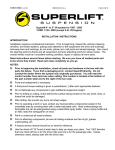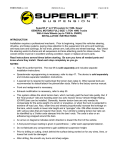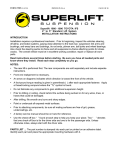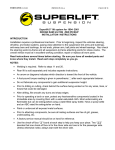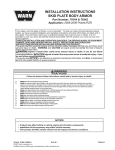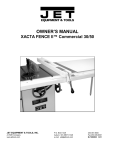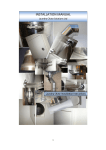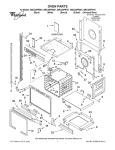Download Installation Instructions
Transcript
FORM #3103.04-082812 PRINTED IN U.S.A. PAGE 1 OF 13 Superlift 2” lift system for 1983- Present G.M. S-10 Blazer /Jimmy, Pickup 4WD INSTALLATION INSTRUCTIONS INTRODUCTION Installation requires a professional mechanic. Prior to beginning, inspect the vehicles steering, driveline, and brake systems, paying close attention to the suspension link arms and bushings, anti-sway bars and bushings, tie rod ends, pitman arm, ball joints and wheel bearings. Also check the steering sector-to-frame and all suspension-to-frame attaching points for stress cracks. The overall vehicle must be in excellent working condition; repair or replace all worn parts. Read instructions several times before starting. Be sure you have all needed parts and know where they install. Read each step completely as you go. NOTES: • The lift you obtain over current height depends if and then how much the torsion bars have been adjusted up. If the bars have already been "cranked-up” 1 inch or so, you can expect that much less lift. It's possible that the new car dealer or the previous owner cranked the bars somewhat. On a S-10 / S-15 with adjusted up bars, the upper control arms extension travel snubbers will be (or almost be) making contact with their travel stops. This "bind" is what makes the truck ride harsh. Installing this Superlift system on a cranked bar truck or one equipped with an aftermarket torsion bar kit will result in 1"-2" lift and an improved ride. Review Step 21. • If you are increasing lift over an existing 1-1/2 " replacement bar system, the vehicle should already be equipped with replacement torsion bars / adjuster arms and rear add-a-leafs. You only need the following Superlift parts: upper control arms (with hardware), rear shackles, and possibly shocks. • A special tool is required to load / unload the torsion bars (step 2). Other special tools are recommended to detach / attach the pitman / idler studs. Refer to the factory service manual. • Front end realignment is necessary. • An arrow on diagrams indicates which direction is toward the front of the vehicle. • A foot-pound torque reading is given in parenthesis ( ) after each appropriate fastener. • Do not fabricate any components to gain additional suspension height. • Prior to drilling or cutting, check behind the surface being worked on for any wires, lines, or hoses that could be damaged. • After drilling, file smooth any burrs and sharp edges. • Prior to operating a torch or saw, protect any heat-sensitive components located in the immediate area by covering them with a water-saturated cloth. Most undercoating are flammable but can be extinguished using a water-filled spray bottle. Have a spray bottle and an ABC rated fire extinguisher on hand. FORM #3103.04-082812 PRINTED IN U.S.A. PAGE 2 OF 13 • All welding must be performed by a certified technician. • Paint or undercoat all exposed metal surfaces. • Prior to attaching components, be sure all mating surfaces are free of grit, grease, undercoatings, etc. • A factory service manual should be on hand for reference. • Use the check-off box “ ” found at each step to help you keep your place. Two “ ” denotes that one check-off box is for the driver side and one is for the passenger side. Unless otherwise noted, always start with the driver side. PARTS LIST … The part number is stamped into each part or printed on an adhesive label. Identify each part and place the appropriate mounting hardware with it. PART NO DESCRIPTION NEW ATTACHING HARDWARE (Qty.- if more than one) (Qty.- if more than one) 55-01-3110................... upper control arm, driver side ...... (2) 90° zerk fitting (4) bushing half (2) 1/2” ID x 2-1/4” serrated sleeve (4) 1/4” x 1” allen head bolt (8) 1/4” flat washer (4) 1/4” stover nut (1) 1/4” x 1/2” bolt (1) 1/4” star washer 55-02-3110 .................. upper control arm, ....................... (2) 90° zerk fitting passenger side (4) bushing half (2) 1/2” ID x 2-1/4” serrated sleeve (4) 1/4” x 1” allen head bolt (8) 1/4” flat washer (4) 1/4” stover nut (1) 1/4” x 1/2” bolt (1) 1/4” star washer 66-01-3103-5 (2) torsion bar adjuster arm 55-01-3103-5 .............. (2) rear spring shackle 55-04-3103 .................. upper shock mounting ................. (2) 1/2” x 2-3/4” bolt brackets, front (2) 1/2” nyloc nut hardware for gas line ................... (1) 1/4” x 3/4” relocation (some applications) (1) 1/4” flat washer (1) 1/4” nyloc nut turning radius stop (2) 3/8” OD x 1” half section tubing 0034 ............................. Superlift badge ............................ alcohol wipe pad 00461 ........................... decal, "Warning To Driver" FORM #3103.04-082812 PRINTED IN U.S.A. PAGE 3 OF 13 REAR PROCEDURE NOTE: The rear is sold separately and is installed first for reference as to how much to adjust the front ride height to level up the vehicle. Rear lift options include replacement spring shackles, add-a-leaves, or both. The following covers the installation procedure for all options; some of these steps may not be necessary depending on which rear lift option was chosen. 1) PRIOR TO BEGINNING INSTALLATION… Have an alignment shop inspect the front upper / lower ball joints, tie-rod ends and idler arm for slack. Replace if needed. 2) PREPARE VEHICLE... Position a floor jack under the center of the rear axle and raise vehicle. Place jack stands underneath the frame rails, just in front of the spring hangers. Ease jack down until frame is resting on stands. Chock front wheels to prevent any possibility of movement. Remove tires, shocks and U-bolts. Save the stock U-bolts for reuse. 3) INSTALLING ADD-A-LEAVES… NOTE: This step is performed only if add-a-leaves have been purchased separately (they are generally recommended for the Blazer / Jimmy). If lift shackles have been purchased, proceed to step 4. Raise up the rear axle and secure it up and out of the way. Remove upper and lower spring shackle bolts and the spring front hanger bolt to allow removal of leaf spring and shackle. For springs equipped with bolt style retaining clamps: Remove the spring bolt / spacer tube that goes through the clip located on the front end of the spring. Position a C-clamp approximately 3- to 4-inches away from the center tie bolt on each side to hold the leaf pack together, then carefully remove the center bolt and remove the Cclamps. WARNING: Use caution when removing the C-clamps since the leaves are "loaded" and will "explode" apart when released. Insert the Superlift leaf directly underneath the main leaf (the first and longest leaf with the eyes). Note that the long end of the new leaf goes toward the rear. Use C-clamps or a press to compress the spring pack. Do not compress the leaf pack with the furnished center-bolt; this will result in stripping the bolt / nut threads. Tighten bolt and trim off excess. Be sure the spring pack is fully compressed on both sides of the clip. The holes in the clip "ears" need to be elongated so the bolt / spacer tube can be used with the thicker spring pack; use a pencil tip die grinder or a rattail file. FORM #3103.04-082812 PRINTED IN U.S.A. PAGE 4 OF 13 For springs equipped with cinch type retaining clamps: Using a torch, heat the “ears” of the retaining straps and use a hammer to bend them outward to allow for leaf pack disassembly. Remove the tie bolt, then carefully loosen the Cclamps. Warning: Use caution when removing the C-clamps since the leaves are “loaded” and will “explode” apart when released. Insert the Superlift leaf directly underneath the main leaf (the first and longest leaf with the eyes). Note that the long end of the new leaf goes toward the rear. Use C-clamps or a press to compress the spring pack. Do not compress the leaf pack with the furnished center-bolt; this will result in stripping the bolt / nut threads. Tighten bolt and trim off excess. Be sure the spring pack is fully compressed on both sides of the retaining clamps. Reheat the clamps and use a hammer to bend them back into their original positions. Allow the clamps to heat naturally and fully before removing the C-clamps. Re-attach the spring to the front hanger, then the shackle using factory hardware; do not tighten at this time. With the jack, ease down the rear axle to its spring attaching points. Be sure the contact points (springs, pads) are clean and the center bolt heads align and seat properly into the pads. Position the U-bolt plates and tighten the stock U-bolts (105) using a "X" torque pattern. With the tires on (refer to step 16) and the vehicle on the ground, manually bounce the rear to somewhat pre-settle the springs. With the full vehicle weight on the springs, torque the attaching points: front and rear spring eye bolts and shackle-to-frame bolts (88). 4) SHACKLES… NOTE: This step is performed only if replacement spring shackles have been purchased. If add-a-leaves are used, proceed to step 5. Position a floor jack so that it supports, but does not raise, the axle assembly. Disconnect the rear spring from the shackle and lower the axle slightly to move the spring out of the way, then remove the hardware securing the shackle to the frame. Inspect the shackle bushings for wear and replace as necessary. Save all hardware for reuse. Position the Superlift shackle (#55-01-3103-5) with the open end toward the front. Loosely install the factory upper / lower shackle bolts. Do not fully tighten at this time. With the tires on (refer to step 16) and the vehicle on the ground, manually bounce the rear to somewhat pre-settle the springs. With the full vehicle weight on the springs, torque the attaching points: rear spring eye bolts and shackle-to-frame bolts (88). 5) SHOCKS… New shocks are required and are available separately from Superlift. Install the rear shocks now per separate instructions. FORM #3103.04-082812 PRINTED IN U.S.A. PAGE 5 OF 13 FRONT PROCEDURE 6) PREPARE VEHICLE… Place vehicle in neutral. Raise the front with a floor jack positioned underneath the front axle crossmember. Place jack stands under the frame rails behind the front wheel wells and lower frame onto the stands. Put vehicle in gear and chock rear wheels to prevent any possibility of movement. Remove tires. 7) UNLOADING THE TORSION BARS… WARNING: Be extremely careful when loading and unloading the torsion bars; there is a tremendous amount of energy stored in them. Keep your hands and body clear of the adjuster arm assembly and the puller tool in case anything slips or breaks. [DIAGRAM 1 and 1a] Note the approximate length of the adjuster bolt exposed below the nut block. You will need this measurement for initial ride height adjustments once the installation is complete. A special torsion bar puller tool is required to unload the torsion bars. Use the tool to load the torsion bar, then remove the adjusting bolt and nut block. Unload the bar and remove the puller tool. Note: Because of the extreme loads generated by the torsion bars on these vehicles, a standard two-jaw puller tool tends to bend the "lips" of the crossmember (which it uses for attachment) and may pop out of place. We have had the best results using a C-clamp type puller tool. If one cannot be found locally, this tool (PN J-22517-C) is available from the Kent Moore Tool Group in Roseville, Michigan (800/345-2233 or 313/774-9500). FORM #3103.04-082812 PRINTED IN U.S.A. PAGE 6 OF 13 With the bar unloaded, slide it further forward into the lower control arm. If the bar seems lodged, use a hammer and punch routed through the hole in back of crossmember. When the bar shifts forward, the adjuster arm will fall free. 8) REMOVE UPPER CONTROL ARMS… Remove the cotter pin and nut. Using a "pickle fork" or other suitable tool, detach the ball joint stud from the knuckle. NOTE : If any stud looseness is detected or you can twist the stud in its socket with your fingers, replace the joint. Regardless of perceived condition, Superlift strongly recommends replacing the ball joints on any high-mileage vehicle. Also, check the tapered hole for deformation / elongation and replace knuckle if necessary. Using a scribe or marking paint, mark the position of the cam bolts for the upper control arms in relation to the frame. It will be necessary to return the cam bolts to their original position for a rough alignment following assembly. The vehicle will need to professionally realigned after the installation is complete. Remove the bolt holding the brake line and ABS wire (if applicable) to the front leg of the upper control arm, then loosen and remove the cam bolts holding the upper control arm to the frame. Save all hardware for reuse. 9) BALL JOINT REMOVAL… NOTE: If the existing ball joints are being reused, they will need to be removed from the factory upper control arms. If new ball joints are purchased, proceed to step 11. Regardless, the factory control arms are not reused and can be discarded. Place the upper control arm in a vise or other suitable solid fixture. From the top, with a 1/8" diameter drill bit, drill into the centers of the 4 ball joint rivets approximately 1/4" deep. Then, with a 1/2" bit, drill just enough to remove the heads. Take care not to drill into the joint. Use a hammer and punch to drive the rivets through. Remove joint from the upper control arm and inspect the joint to ensure it has not been damaged. 10) BALL JOINT INSTALLATION… [DIAGRAM 2] Be sure the ball joint / Superlift upper control arm mating points are clean. Insert the ball joint in the Superlift upper control arm from the top and secure using the supplied 1/4” x 1” Grade 8 allen-head bolts, flat washers, and stover nuts (The 2 outside joint attaching holes are elongated to work with both early and late models).These bolts should be installed from the top to allow for wrench clearance, and the supplied flat washers should be placed under both the bolt heads and the nuts. Apply the supplied Loctite No. 24200 to bolt/nut threads and torque locking nuts (25). FORM #3103.04-082812 PRINTED IN U.S.A. PAGE 7 OF 13 11) INSPECT CV BOOTS… Closely inspect the inner and outer CV boots for excessive wear, cracking, or splitting. If damage is present, replace the CV boots before continuing. Replacement CV boots are available separately from Superlift (Part #3100). 12) UPPER CONTROL ARM… [Diagram 2] The Polyurethane control arm eye bushings with steel sleeves and the extension travel snubber should already be installed on the new arm. Attach arm to the frame using the factory cam bolt assemblies according to the diagram. Adjust both cams to the alignment marks made during disassembly for temporary alignment; torque (45). Install the two 90º grease fittings and lubricate the eye bushings with a good quality, high temperature, water resistant grease. If needed, use Loctite No. 24200 to secure fittings in the desired "facing outward" position. NOTE: On 1987 and newer models, clearance between the inside of the control arms rear leg and the rebound snubber bracketry is very close. Check clearance with the arm eyes attached and with the snubber resting on its stop. If necessary, re-form the bracket with a hammer. The stamped bracket with bend relatively easy, especially if heated. 13) KNUCKLE ASSEMBLY… Attach knuckle to the upper ball joint; torque slotted nut (65) and install cotter pin. Attach the brake hose bracket to the bottom of the front tube of the control arm with the furnished 1/4 "x 1" bolt and external tooth lock washer. Straighten out the bend in the bracket so that the hose is routed parallel and towards the inside of the control arm leg. This prevents possible tire-to-hose contact while turning sharply. Install front shock. 14) FRONT SHOCK UPPER MOUNT RELOCATING BRACKET… [DIAGRAM 3] Install the shock mount relocating bracket (#55-04-3103) in shock tower, with radius to the rear. Install furnished 1/2" x 2-3/4" bolt into tower through bracket. With a hammer tap bracket up to snug against top of tower. FORM #3103.04-082812 PRINTED IN U.S.A. PAGE 8 OF 13 Weld a 3/4 " bead as shown in Diagram 3. Tighten 1/2" bolt (70). Touch up weld & bracket with spray can or undercoating. NOTE: On certain applications, the driver side shock tower has a 5/16" bolt installed to hold gas line clamp. Remove bolt and discard. Install the furnished 1/4" x 3/4" bolt from the bottom, then install the clamp, flat washer, lock washer and nut. Tighten (12). 15) INSTALLING NEW TORSION BAR ADJUSTER ARMS... [DIAGRAM 1a] Clean the hex splines on the torsion bar and apply a light lubricating grease. Position the Superlift adjuster arm in the crossmember. When indexed properly, the bottom edge of the adjuster arm is basically flush with the bottom edge of the crossmember. Shift the torsion bar rearward into the adjuster arm. Position the special puller tool used during disassembly. Load the puller / bar and install the adjuster nut. Again, be careful! Unload and remove puller, then thread the adjuster bolt into the nut until the arm is raised approximately 1/4" off of the nut. 16) LOADING THE TORISON BARS… Lubricate the torsion bar adjuster bolts and the torsion bar puller tool threads. Install the torsion bar tool and load the torsion bars enough to install the adjuster bolt and nut block. Make sure the length of the adjuster bolt exposed below the nut block is the same as the original. 17) TIRES / WHEELS... [DIAGRAM 4] Tighten the lug nuts to factory specs in the sequence shown. FORM #3103.04-082812 PRINTED IN U.S.A. PAGE 9 OF 13 NOTE: Some deeply inset wheels, when turned full lock, may make slight contact with the upper control arm. Even if the wheels are not making contact, the close clearance may interfere with wheel balancing weights. If either problem exists, weld the furnished 3/8" O.D. x 1" long piece of half-section tubing onto both factory turning radius stops, located at the rear of the lower control arms - refer to Diagram 5. It may be necessary to abandon knock-on weights in favor of tape-ons. WARNING: When the tires / wheels are installed, always check for and remove any corrosion, dirt, or foreign material on the wheel mounting surface, or anything that contacts the wheel mounting surface (hub, rotor, etc.). Installing wheels without the proper metal-tometal contact at the wheel mounting surfaces can cause the lug nuts to loosen and the wheel to come off while the vehicle is in motion. WARNING: Retighten lug nuts at 500 miles after any wheel change, or anytime the lug nuts are loosened. Failure to do so could cause wheels to come off while vehicle is in motion. 18) CLEARANCE CHECK... With the vehicle still on jack stands, and the suspension “hanging” at full extension travel, cycle steering lock-to-lock and check all components for proper operation and clearances. Pay special attention to the clearance between the tires / wheels and brake hoses, wiring, etc. Lower vehicle to the floor. 19) FINAL PROCEDURES… Re-torque everything that has been touched and double check for cotter pins. FORM #3103.04-082812 PRINTED IN U.S.A. PAGE 10 OF 13 20) ADJUSTING FRONT RIDE HEIGHT... Manually bounce the front and rear of vehicle to normalize the torsion bars and leaf springs. [DIAGRAM 5] Position the vehicle on a level surface. Measure from the LCA front pivot bolt center down to the floor. Record this as Measurement “B”. Now measure from the inside edge of the knuckle (at the lower ball joint boss) down to the floor. Record this as Measurement “A”. Subtract Measurement “A” from “B” for the ride height figure. Minimum ride height is 4.75”; maximum is 6.75”. Ideal ride height is somewhere in between. Raise height by tightening the torsion bar adjusting bolt; lower height by loosening the bolt. You may need to adjust each side differently to get the vehicle level (side to side). Adjust height 3/8” to 1/2” above the final desired ride height, since the bars will settle slightly after the vehicle is driven. IMPORTANT NOTE: It is possible to adjust up the bars too much. The lift limiting factor is the angle of the Constant Velocity type front axles. On the majority of vehicles, the upper control arm snubber will be within 1/2" of making contact with its stop when the vehicle is at full operational lift. An indication of too much lift, or C.V. angle, is a binding, grinding type vibration coming from the front axles. The result is excessive C.V. joint wear and/or failure. Another possible problem with excessive lift is premature C.V. boot failure. This is especially true with 1985 and newer models equipped with the relatively stiff urethane boots, as compared to the pliable neoprene boots found on the 1983-84 models. On these models, even at 2" of lift, you will experience a shortened boot service life. If plastic boot failure occurs and you do not want to lower the ride height, try installing 1983-84 inner boots (for either end). The inner boots short length and greater flexibility will yield a longer service life. If boot failure continues, the only alternative is to lower the vehicle ride height. The difference between measurements "A" and "B" will not exceed 4.5" on a stock vehicle. This differential cannot exceed 6.75" which means 2" of lift. To ensure proper C.V. operation and service life as well as proper alignment, the 2" maximum lift height must not be exceeded. 21) REBOUND (extension) TRAVEL ADJUSTMENT… After ride height adjustment is complete, check clearance between the Superlift Polyurethane upper control arm snubbers and their travel stop contact points. At full lift with the suspension loaded there is normally approx. 1-1/8" clearance. Raise the vehicle as per STEP 8 and let the suspension "hang" unloaded. Manually spin the front tires and check for C.V. bind. If binding occurs, shim the Poly-snubbers down closer to their stops with large diameter flat-washers (or something similar) until binding stops. Lower vehicle to the floor. Again, with the vehicle on the ground, cycle the steering lock-to-lock. Be sure the steering/suspension is functioning properly. Check for adequate clearance at front shocks-toC.V. boots and at brake hose-to-wheels. FORM #3103.04-082812 PRINTED IN U.S.A. PAGE 11 OF 13 22) TURNING RADIUS STOP EXTENSIONS… With the vehicle on the ground, turn the wheels right full lock and inspect the clearance between the wheels and the upper control arms. Repeat inspection with the wheels left full lock. NOTE: Some deeply inset wheels, when turning full lock, may make slight contact with the upper control arms. Even if the wheels are not making contact, the close clearance may interfere with wheel balancing weights. If either problem exists, perform the following steps one side at a time, starting with the driver side. [DIAGRAM 5] Locate the 3/8” ID x 1” long half-section of tubing provided in the hardware bag and refer to the diagram for location of the turning radius stops on the lower control arms. Position the half section of tubing over the turning stop on the lower control arm and weld the tubing in place. NOTE: It may be necessary to use tape-on balancing weights instead of knock-on weights to gain the desired clearance. 23) ALIGNMENT… Have a reputable alignment shop align the vehicle to the following specifications: CASTER - To increase positive caster, move front lobe inboard and rear cam lobe outboard. CAMBER- To increase positive camber, move both front and rear lobes inboard. Minimum Preferred Maximum CASTER (Degrees) +1 +2 +3 Side-to-Side Variation 1-1/2 CAMBER (Degrees) 0 +1/2 + 1-1/2 23/32 TOE-IN (Inches) 1/16 1/8 1/4 ---- 24) FINAL CLEARANCE and TORQUE CHECK... With vehicle on floor, cycle steering lock-to-lock and inspect the tires / wheels, and the steering, suspension, and brake systems for proper operation, tightness, and adequate clearance. 25) Activate four wheel drive system and check front hubs for engagement 26) HEADLIGHTS... Readjust headlights to proper setting. 27) SUPERLIFT NAME BADGE AND WARNING DECAL... The system includes one 2” x 5” name badge (#0034). Additional and / or larger badges are available from Superlift or a Superlift dealer. We suggest putting the badges on the front FORM #3103.04-082812 PRINTED IN U.S.A. PAGE 12 OF 13 fenders, tailgate, or rear window. The badge mounts by means of factory applied, doublebacked tape. Follow these instructions to ensure that badge sticks properly: Clean designated area with warm, soapy water. Rinse and wipe dry with a soft, lint free towel. Thoroughly prep the area with the furnished alcohol wipe pad and wipe dry with a soft, lint free towel. Do not touch the surface again with your hands; they transfer body oils. Remove mounting tape backing, line up badge, and press in place. Do not touch mounting tape or allow tape to get dirty. Press firmly on the badge face and hold a few seconds to seat mounting tape. A superior adhesive bond forms over time. We recommend allowing 24 hours of cure time before washing and waxing. The emblem itself can be cleaned with any glass cleaner. Install the WARNING TO DRIVER decal on the inside of the windshield, or on the dash, within driver’s view. Refer to the “NOTICE TO DEALER AND VEHICLE OWNER” section below. Limited Lifetime Warranty / Warnings ® Your Superlift product is covered by the Limited Warranty explained below that gives you specific legal rights. This ® ® limited warranty is the only warranty Superlift makes in connection with your product purchase. Superlift neither assumes nor authorizes any retailer or other person or entity to assume for it any other obligation or liability in connection with this product or limited warranty. ® What is covered? Subject to the terms below, Superlift will repair or replace its products found defective in materials or workmanship for so long as the original purchaser owns the vehicle on which the product was originally ® ® installed. Your warrantor is LKI Enterprises, Inc. d/b/a Superlift Suspension Systems (“Superlift ”). ® What is not covered? Your Superlift Limited Warranty does not cover products, parts or vehicles Superlift® determines to have been damaged by or subjected to: • Alteration, modification or failure to maintain. • Normal wear and tear (bushings, tie-rod ends, etc.). Scratches or defects in product finishes (powdercoating, plating, etc.), • Damage to or resulting from vehicle’s electronic stability system, related components or other vehicle systems. • Racing or other vehicle competitions or contests. Accidents, impact by rocks, trees, obstacles or other aspects of the environment. • Theft, vandalism or other intentional damage. Remedy Limited to Repair / Replacement. The exclusive remedy provided hereunder shall, upon Superlift’s inspection and at Superlift’s option, be either repair or replacement of product or parts covered under this Limited ® Warranty. Customers requesting warranty consideration should contact Superlift by phone (1-800-551-4955) to obtain a Returned Goods Authorization number. All removal, shipping and installation costs are customer’s responsibility. ® If a replacement part is needed before the Superlift part in question can be returned, you must first purchase the replacement part. Then, if the part in question is deemed warrantable, you will be credited / refunded. Other Limitations - Exclusion of Damages - Your Rights Under State Law ® ® • Neither Superlift nor your independent Superlift dealer are responsible for any time loss, rental costs, or for any incidental, consequential or other damages you may have. FORM #3103.04-082812 PRINTED IN U.S.A. PAGE 13 OF 13 • This Limited Warranty gives you specific rights. You may also have other rights that vary from state to state. For example, while all implied warranties are disclaimed herein, any implied warranty required by law is limited to the terms of our Limited Lifetime Warranty as described above. Some states do not allow limitations of how long an implied warranty lasts and / or do not allow the exclusion or limitation of incidental or consequential damages, so the limitations and exclusions herein may not apply to you. Important Product Use and Safety Information / Warnings As a general rule, the taller a vehicle is, the easier it will roll over. Offset, as much as possible, what is lost in rollover resistance by increasing tire track width. In other words, go “wide” as you go “tall”. Many sportsmen remove their mud tires after hunting season and install ones more appropriate for street driving; always use as wide a tire and wheel combination as feasible to enhance vehicle stability. We strongly recommend, because of rollover possibility, that the vehicle be equipped with a functional roll bar and cage system. Seat belts and shoulder harnesses should be worn at all times. Avoid situations where a side rollover may occur. Generally, braking performance and capabilities are decreased when significantly larger / heavier tires and wheels are used. Take this into consideration while driving. Also, changing axle gear ratios or using tires that are taller or shorter than factory height will cause an erroneous speedometer reading. On vehicles equipped with an electronic speedometer, the speed signal impacts other important functions as well. Speedometer recalibration for both mechanical and electronic types is highly recommended. Do not add, alter, or fabricate any factory or aftermarket parts to increase vehicle height over the intended height of the Superlift product purchased. Mixing component brands is not recommended. ® ® All Superlift material is copyrighted. All images found in this catalog and in any Superlift marketing forums are the ® sole property of or licensed to Superlift . Any reproduction of said materials, in part or in whole, with out the express ® ® written permission of Superlift is strictly forbidden. Superlift , Rockrunner™, Swamprunner™, Superide™, Superide ® SS™ and SSR™, Black Diamond , XCL™, X2™ Super Trac™, Torque Max™, Torque Max SS™, eXtreme Ring™, Rail Wrap™, Bullet Proof Brake Hose™, TruSpeed™, Frame Integrated Technology™, F.I.T. Series™ and Rock ™ ® ® Fink are registered trademarks of Superlift Suspension Systems. Superlift Suspension Systems is a Division of Bret Lovett’s Lift Kits Incorporated. SUPERLIFT SUSPENSION SYSTEMS 300 Huey Lenard Loop Rd. West Monroe, Louisiana 71292 Phone: (318) 397-3000 Sales / Tech: 1-800-551-4955 FAX: (318) 397-3040 www.superlift.com













